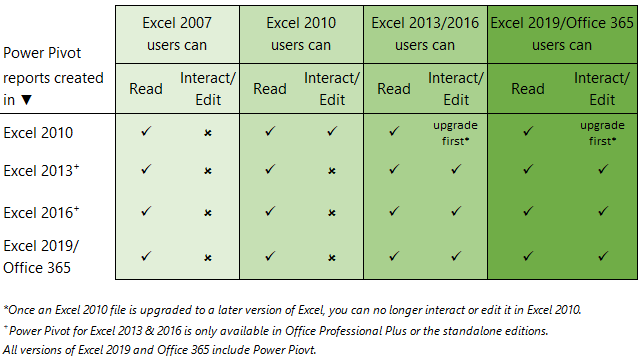

- #POWER PIVOT FOR EXCEL 2016 HOME AND BUSINESS ZIP FILE#
- #POWER PIVOT FOR EXCEL 2016 HOME AND BUSINESS CODE#
- #POWER PIVOT FOR EXCEL 2016 HOME AND BUSINESS DOWNLOAD#
Then just browse to the location of the Access database (it is in the zip file with the Excel workbook), select the Access database, Click Open\Save\Close. To do this, go to the Power Pivot Window, select Home\Existing Connections and then select the Access connection (#1 below) and then click Edit (#2).

If you are following along with the samples, the first task is to reconnect the Power Pivot Workbook to the Access Database. The reason I am doing this is that this is my most common use case – I have a report (typically large – maybe 200MB, and someone wants a variation). Make sure you unzip the files into a folder – don’t use the files from a zipped folder else the next steps may not work.
#POWER PIVOT FOR EXCEL 2016 HOME AND BUSINESS DOWNLOAD#
You can Download the files I used from here if you want to play along. The sample I am using is a typical Adventure Works report that I built some time ago for another blog post. I want to start with a data model that already is loaded with data built and is up and running. Changing the Import Approach of a Loaded Table
#POWER PIVOT FOR EXCEL 2016 HOME AND BUSINESS CODE#
You can’t write SQL code to selectively import CSV data for example. Note: You can only use SQL if you have a supported database as a source. Now I know better and I am going to share with you why I now routinely use option 2. I would ALWAYS use option 1 and I would NEVER use option 2. When I first saw the 2 options in this dialogue, it was very clear to me. One of the first dialogue boxes you will ever see in Power Pivot for Excel is this one. Allow you to store these loading variations in a bespoke workbook rather than in the source database.īut enough of that – let’s get into it.Allow you to import smaller lookup tables based on the subset of records in your data table(s).It can help you significantly improve the compression and hence performance of your larger reports.Allow you to import a non-contiguous subset of records into your data tables that filters out unwanted data – something that is otherwise difficult to achieve with the standard UI.The same opportunity exists with Power BI but with a different UI experience – I will not cover the Power BI UI in this post. With some SQL skills, you can add significant flexibility to your data acquisition and loading processes into Power Pivot. If you use Power Pivot for Excel and you directly source your data from a database, learning some basic SQL will help you get significantly more value from the process of loading your data. The chance of getting something wrong is relatively low (for these simple queries anyhow – see warning at the end).When you need to do something more complex, the Internet is just a quick Google away.You can start with simple short queries and get more complex only when you need to.It has a very simple syntax that uses English language expressions.The reasons SQL is easy to learn include: SQL is one of the easiest languages I have ever taught myself and you can do it too. Today I am going to spend some time trying to convince (and demonstrate to) Excel Power Pivot users that it is easy and valuable to learn some simple SQL code.


 0 kommentar(er)
0 kommentar(er)
